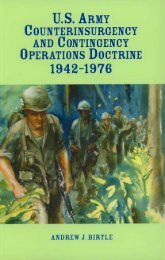C. Wiebes - Intelligence en de oorlog in Bosnië 1992-1995. De rol van de inlichtingen- en veiligheidsdiensten - Engels
C. Wiebes - Intelligence en de oorlog in Bosnië 1992-1995. De rol van de inlichtingen- en veiligheidsdiensten - Engels
C. Wiebes - Intelligence en de oorlog in Bosnië 1992-1995. De rol van de inlichtingen- en veiligheidsdiensten - Engels
- No tags were found...
You also want an ePaper? Increase the reach of your titles
YUMPU automatically turns print PDFs into web optimized ePapers that Google loves.
217million messages, s<strong>en</strong>t via Intelsat and Inmarsat communications satellites, were <strong>in</strong>tercepted eachmonth. The technical structure was strongly upgra<strong>de</strong>d from 1994 onwards. The problem was that theNSA ‘was buy<strong>in</strong>g all these new toys, but they don’t have the people to use them’, accord<strong>in</strong>g to an<strong>in</strong>tellig<strong>en</strong>ce expert. 1151 The <strong>in</strong>evitable happ<strong>en</strong>ed: the NSA found itself unable to process the <strong>en</strong>ormousflow of <strong>in</strong>tercepts. 1152The greatest problem for the ag<strong>en</strong>cy proved to be ‘the cont<strong>in</strong>u<strong>in</strong>g <strong>de</strong>cl<strong>in</strong>e of its Sig<strong>in</strong>tprocess<strong>in</strong>g, analysis and report<strong>in</strong>g <strong>in</strong>frastructure’. There was a major lack of tra<strong>in</strong>ed personnel as aresult of early resignations and <strong>de</strong>partures for the private sector. Around 1995 the service was <strong>in</strong> serioustrouble, because there was no money available to recruit new and compet<strong>en</strong>t personnel. The NSA<strong>en</strong>countered ‘a particularly severe problem with the size, age, skills and make-up of its workforce’.Internal problems probably also created further obstacles to the ‘free flow of <strong>in</strong>tellig<strong>en</strong>ce <strong>in</strong>formationto the Ag<strong>en</strong>cy’s customers’. In<strong>de</strong>ed, the <strong>in</strong>ternal communications systems with<strong>in</strong> the NSA proved to bequestionable. 1153 Moreover, the NSA is said to have had a poor relationship with the P<strong>en</strong>tagon, whichoft<strong>en</strong> compla<strong>in</strong>ed about the NSA’s unwill<strong>in</strong>gness to share Sig<strong>in</strong>t for fear of compromis<strong>in</strong>g thesource. 1154 P<strong>en</strong>tagon staff op<strong>en</strong>ly compla<strong>in</strong>ed that the NSA was oft<strong>en</strong> unwill<strong>in</strong>g to part with the militarySig<strong>in</strong>t that they nee<strong>de</strong>d to carry out their tasks. One P<strong>en</strong>tagon employee ev<strong>en</strong> said that staff of the NSA‘are still fight<strong>in</strong>g the Cold War and are more worried about ma<strong>in</strong>ta<strong>in</strong><strong>in</strong>g security than improv<strong>in</strong>g tacticalwarfight<strong>in</strong>g capabilities’. 1155 In short, besi<strong>de</strong>s the <strong>in</strong>her<strong>en</strong>t objection to shar<strong>in</strong>g high-level Com<strong>in</strong>t,<strong>in</strong>suffici<strong>en</strong>t analysis capabilities and <strong>in</strong>ternal bureaucratic struggles proved a further h<strong>in</strong>drance to theexchange of Sig<strong>in</strong>t.The <strong>in</strong>itial lack of US Com<strong>in</strong>t capabilities was also revealed by the creation of an <strong>in</strong>tellig<strong>en</strong>ceunit at the Southern European NATO Command at Naples (AFSOUTH), known as the <strong>De</strong>ployedShed Facility (DSF). The chief American reason for participat<strong>in</strong>g <strong>in</strong> this <strong>in</strong>tellig<strong>en</strong>ce unit was that the1156NSA had major gaps <strong>in</strong> its Sig<strong>in</strong>t <strong>in</strong> Bosnia. The NSA did not have the personnel capacity to manthis unit on a 24-hour basis, so other countries were asked to help out; reportedly the NetherlandsMilitary <strong>Intellig<strong>en</strong>ce</strong> Service (MIS) also had to contribute to this mult<strong>in</strong>ational unit. 1157 The proposalwas supported by NATO, but before the Head of the MIS, Piet Duijn, was prepared to agree to this hefirst wanted to know the view of <strong>De</strong>f<strong>en</strong>ce M<strong>in</strong>ister, Relus ter Beek, who immediately agreed toparticipation. 1158In the course of time the US services became prepared to share more Sig<strong>in</strong>t. The U-2reconnaissance aircraft were also able to supply valuable Sig<strong>in</strong>t. The US services wanted to contributethis to the mult<strong>in</strong>ational gather<strong>in</strong>g and process<strong>in</strong>g unit <strong>in</strong> Vic<strong>en</strong>za, which was to work closely with th<strong>en</strong>ew DSF. In adm<strong>in</strong>istrative terms this cell would report to NATO; the MIS supplied personnel for thisunit too. 1159 Apart from the LOCE system, and with<strong>in</strong> the DSF, the NATO member states alsomutually exchanged Sig<strong>in</strong>t on Bosnia. This took place (and takes place) traditionally on a bilateral basis.There was also a regular exchange betwe<strong>en</strong> NATO member states and non-alliance countries such asAustria and F<strong>in</strong>land, and also with neutral states such as Switzerland and Swed<strong>en</strong>.1151 Confid<strong>en</strong>tial <strong>in</strong>terview (62).1152 Seymour M. Hersh, ‘The <strong>Intellig<strong>en</strong>ce</strong> Gap: How the Digital Age Left Our Spies Out <strong>in</strong> the Cold’, The New Yorker,06/12/99, p. 58 ff.1153 See: Matthew M. Aid, ‘The Time of Troubles: The US NSA <strong>in</strong> the Tw<strong>en</strong>ty-First C<strong>en</strong>tury’, <strong>in</strong>: <strong>Intellig<strong>en</strong>ce</strong> and NationalSecurity, Vol. 15 (2000) 3, pp. 1-32.1154 Matthew M. Aid, ‘The Time of Troubles: The US NSA <strong>in</strong> the Tw<strong>en</strong>ty-First C<strong>en</strong>tury’, <strong>in</strong>: <strong>Intellig<strong>en</strong>ce</strong> and National Security,Vol. 15 (2000) 3, pp. 17-20.1155 David Fulgrum, ‘Compute Combat Rules Frustrate the P<strong>en</strong>tagon’, Aviation Week & Space Technology, 15/09/97, p. 68.1156 Confid<strong>en</strong>tial <strong>in</strong>terview (22).1157 MoD, MIS/CO. No. 14312, Report of Direct<strong>in</strong>g Council, no. DIS/93/157/1645, 23/04/93.1158 MoD, DS. no. 335, Memorandum from Commodore P.J. Duijn, no. DIS/93/214/1474, 28/04/93 and Memorandumfrom Comman<strong>de</strong>r J. Waltmann to the M<strong>in</strong>ister, no. SN93/938/2918, 12/05/93.1159 MoD, MIS/CO. HMID Kok to the M<strong>in</strong>ister of <strong>De</strong>f<strong>en</strong>ce, no. DIS/95/50.1/1366, 09/06/<strong>1995.</strong>





